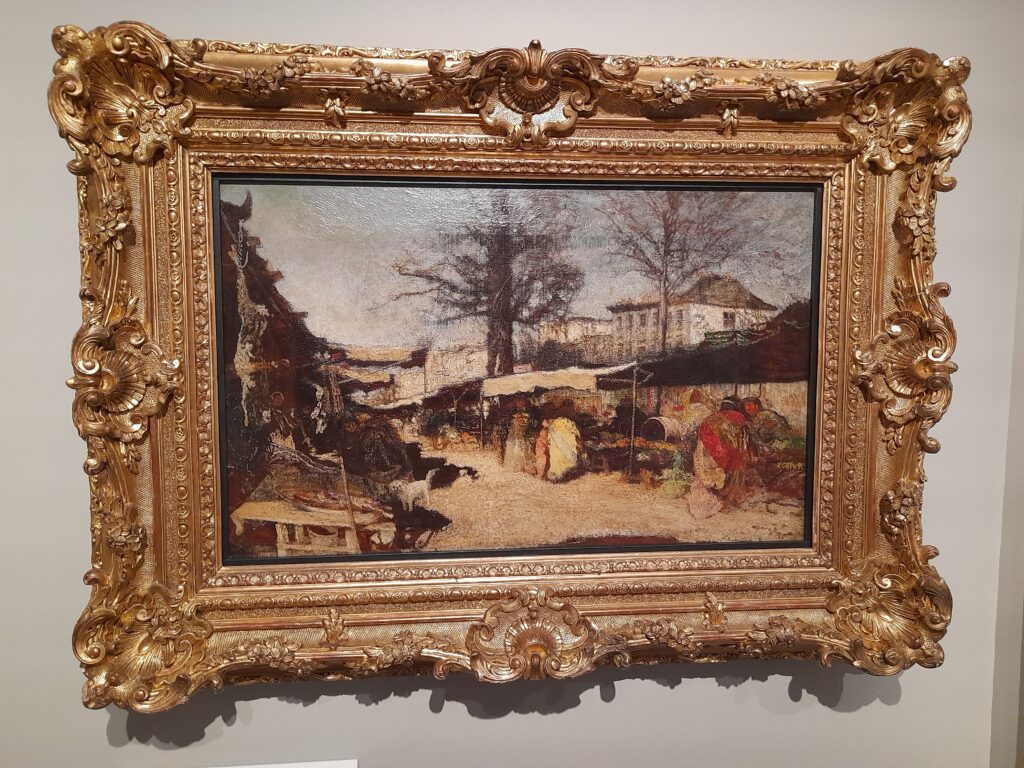It is in human nature to assimilate beliefs, prejudices, vices, virtues and techniques of painting pictures. Even the briefest of biographical notes of the major painters of the modern era describe how artists influenced each other and adopted/borrowed the skills of their associates.
The painting by the French artist Adolphe Monticelli (1824-1886) in the Burrell Collection in Glasgow – ‘The Bazaar, Marseilles’ strikes an interesting note. Burrell was drawn to the artist’s unique style which predated that of the impressionists.
Having received an artistic training at the École Municipale de Dessin in Marseille under Augustin Aubert from 1842 to 1846, Monticelli continued his artistic training through various episodes in Paris. Favourite compositions extensively studied by Monticelli at this time included old masters in the the Louvre. He experienced some measure of success with his works in the 1860’s.
As a young artist Paul Cézanne met up with Monticelli in the 1860s, and the influence of Monticelli’s work can be seen in his paintings around this time. Subsequently between 1878 and 1884 they would on occasion paint landscapes together.
Leaving Paris in 1870, as a result of the outbreak of the Franco-Prussian War, he worked eventually returned (on foot) to his native Marseilles in 1871. He would essentially remain in Marseilles, painting in his characteristic style but receiving little if any local recognition for his artistic endeavours and ending his days in poverty.
Vincent Van Gough was impressed with Monticelli’s works and openly admitted the lasting effect of Monticelli on his own creative output and painting methods. Vincent and his brother would subsequently publish a book on Monticelli’s work following his death in 1886. It is through Vincent’s letters that we draw closer to the aspects of Monticelli’s world of colour in which he describes the thrill of observing pure oil colour pigment on canvas in the clear white light of southern France. Perhaps there is a missing link in all of this where during Covid lockdown in the United Kingdom the reduced air pollution rendered at times the open sky more blue and the light more penetrating. Was the quality of light in 19th century France in some way superior to that prevailing there today that made oil painting outdoors subtlety different?
While Monticelli’s work attracted high prices after his death, this level of interest has significantly waned with some curators of major collections are openly highly critical of his output. Sotheby’s sales register, however, indicates an active interest in his works and also revealing biographical details.
Recently the set of paintings by Monticelli in the National Gallery in London has been studied in some considerable detail, using state of the art technology to analyse aspects such as painting construction and pigment utilisation. The subsequent report detailing such investigations sheds fresh light on Monticelli’s techniques, such as a common practice of painting on wooden panels salvaged from items of domestic furniture. At least two of the such works in the gallery’s collection are thought, however, to be fakes and only a limited number of verified paintings by Monticelli remain on display in the London gallery.
Thanks to the Burrell Collection, however, in we have in Monticelli’s ‘The Bazaar, Marseilles’ a reminder of a life given up to painting within an era that continues to fascinate western culture and where some of the world’s painting masterpieces can be seen to borrow from the style of the ‘old man’.
